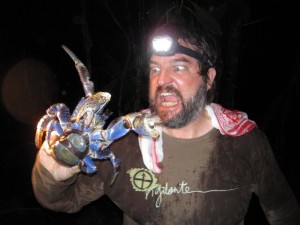Niue: Stalking the Giant Uga
Niue for AAP

On a tiny Pacific Island, man still hunts to survive. Roderick Eime, goes in search of a real prehistoric monster that still haunts the Polynesian rainforest.
The uga (pronounced OONG-a) is not to be trifled with. It is a truly hideous beast that lives deep in the damp Niuean tropical forest and is the source of legend, rumour and folklore. Its claws, like deft mechanical pincers, can easily dismember a human in a blink and its demeanour is nothing short of monstrous. It is the world’s largest terrestrial arthropod.
It’s close to 9pm as we huddle with our guide Tony Aholima in a picnic shelter at Mutalau as a rain squall passes across the top of the tiny island nation of Niue (pronounced NOO-ay). Four of us are preparing to venture into the dense undergrowth in pursuit of this creature and Tony carries a large empty rice sack into which the captured beasts are to be flung. “We’ll get a big one tonight, I’m sure,” says Tony with a gleeful look that belies the impending danger.
Two days prior, we set traps along an overgrown rocky path designed to lure the uga from its lair in the jagged coral rock that is the substrate of the entire island. The traps, thankfully not maidens pegged to tree trunks, but simply ripe juicy coconuts split open and wedged into the crevasses - irresistible to the ravenous nocturnal hunter.
Niue, known in South Pacific circles as the "Rock of Polynesia", is just 259 sq km and perhaps the smallest nation in the world with just 1500 residents, although another 15,000 ‘nationals’ live throughout the Pacific, mainly New Zealand. Despite its size and population, Niue punches above its weight in both sporting and cultural circles. The men, lean and fit, are renowned rugby players, while the women dominate the region’s beauty pageants such as the coveted “Miss South Pacific” where they have captured the title twice in the last five years.
Located 600 kilometres northeast from Tonga, Niue enjoys a relaxed and unhurried pace that is laid back even by Pacific standards. The impeccably groomed and spotless communities are a far cry from some of their islands neighbours and the rich diet of fish gives Niueans a long healthy life. There are no mobile phones and I’m told the first ATM is on the monthly supply ship due next week. There’s free Wi-Fi though.
Sustainable tourism is not a token cliché on Niue, it is a necessity. With limited natural resources and hotel beds, tourism forms a delicate but important thread in the fabric of Niuean life. Air New Zealand flies in and out just once each week with a 152-seat A320, upped recently from a 737, but more capacity is being sought and a second flight, possibly via Tonga, is being negotiated. Visitors come to enjoy the superb scuba diving and snorkelling, where whales and dolphin encounters are more often than not, deep sea fishing (just a few hundred metres off shore), nature walks and the famed uga hunting.
Enough team talk, it’s time to set off on the hunt. We don LED head-torches and creep into the dark forest as fat rain drops catch our beams and create a dazzling curtain through which we walk. Barney the wonder dog, trots noisily by our side while the percussion of the heavy drops on the big leaves creates a sinister soundtrack. Suddenly there’s a loud crash behind me and an unprintable curse. I spin around expecting to see fellow hunter, Nick, in the jaws of an uga. There’s blood, but he’s just slipped on the slimy path and grazed himself. The casualties begin, but we press on.
“Wait here,” whispers Tony loudly, and he ventures ahead as we all crane for a look. “Come!” He signals to me with a vigorous hand gesture and shines the torch towards the coconut we laid out before. Sure enough, one of the creatures has succumbed to temptation and is perched menacingly on a pile of husks. Tony draws breath between clenched teeth, “I told you we’d see a big one!”
Tony moves in and the bright purple animal, alerted and on the defensive, rears up with its fearsome claws ready to remove any accessible appendage. But Tony is too quick; he lunges and snatches the beast behind the neck hoisting it up triumphantly. Young sisters, Tess and Elsbeth, squeal as much in delight as fear, but before the angry crustacean is secured in the sack, the victorious hunters pose for photos.
The uga, Birgus latro, is also known commonly as the coconut or robber crab and still lives in sufficient numbers on Niue to allow careful harvesting. Looking ominously like the dreaded face-hugger from Ridley Scott’s Alien movies, it is also common but protected on Christmas Island in the Indian Ocean, their populations are delicate elsewhere. While our prize is about the size of a football, specimens up to one metre across and over ten kilograms have been recorded.
Soaked to the skin, but satisfied in our haul of the grotesque delicacy, we pile back into Tony’s ute. “C’mon Barney, curry time!”
IF YOU GO
GETTING THERE,
Air New Zealand flies weekly from Auckland each Friday morning. (Flight NZ784) www.airnewzealand.com
STAYING THERE
The premier accommodation offering is the Matavei Resort but there are several more modest lodgings available too. See www.niueisland.com/hotels/ for details.
PLAYING THERE
Niue offers excellent scuba diving, fishing, nature walks and caving. Try a vaka (outrigger canoe) paddle or snorkel. A range of café-style restaurants are in the main town at Alofi and a 9-hole golf course is adjacent to the airport.
For details of all activities, tours and travel, see www.niueisland.com